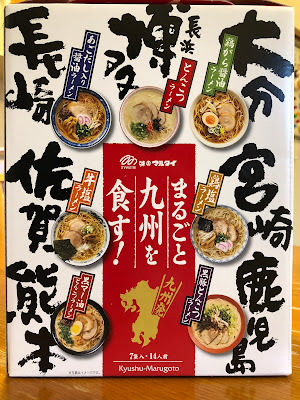Nissin Hong Kong has been making pretty good instant noodles there for a long time. I remember when Doll Ramen was the only game in Hong Kong before they were bought out by Nissin Japan in the late 1980s. Doll Ramen is still making noodles, but Nissin HK is now the number one brand in Hong Kong. Nissin HK makes localized products for the Hong Kong and export markets. Many of the products are imported into Canada, making these noodles available at Superstore and many Asian supermarkets.
One of the more recent products from Nissin HK is the black garlic Tonkotsu ramen flavour of instant noodles. This flavour was first introduced as a packaged noodle block and is a really tasty version of tonkotsu. The extra black garlic paste foil pouch really improved on the original green packages of tonktosu noodle blocks that were out. On a side note, the green packages of tonkotsu noodle blocks now come with a seasoning sauce pouch and not just a powdered soup base which has amped up their flavour too!
When I first saw the Black Garlic Tonkotsu ramen bowls I only thought I should buy like four of these as I knew I liked the flavour of the packaged noodles. The bowls always come with a nice satchet of extra toppings for the noodles which I like too. I was wondering if they were a limited edition product, but it turns out they aren't and the world is a better place because of this.
 |
Three Quarters view of the noodle bowl. It is very distinguishable on the shelf due to the bold black and white color scheme. This black and white colour scheme is almost like yin and yang that shows up consistently in the graphic design. There is the little noodle vendor mascot from Nissin displayed on the side along with the noodle. The lids on these noodle cups tend to just be pasted on and aren't oriented to the front.
|
 |
Lid of the noodle cup. It displays a bowl of creamy tonkotsu ramen with the blackened garlic oil on top. A nice heaping of toppings is also show. I like how the white on the lid represents steam coming off the noodles and not just a graphic design balance. The gold trim to the left side of the steam adds a nice classy touch.
|
 |
Cooking directions. Not for microwave. Add boiling water.
|
 |
Ingredients and manufacturers information.
|
 |
Nutritional information. Pretty typical for fried noodles. But it is salty! If you don't want all that salt then just don't drink the soup.
|
 |
Opening the bowl shows three satchets of stuff along with the noodle block. You get a powdered soup base, dried toppings, and a foil packet of black garlic oil/paste.
|
 |
Dried toppings include corn, carrot, green onion, and naruto (dried fish cake).
|
 |
Toppings and powdered soup base added on top of the noodle block.
|
 |
Add boiling water to the fill line on the inside of the cup. Wait three minutes for the noodle to rehydrate and soften properly.
|
 |
The noodle soup is now ready to eat.
|
 |
The last step is to add the black garlic paste / oil. You will need to stir it well.
|
 |
The finished bowl of noodles. You can see the black garlic oil floating on top.
|
This variety of noodles is a favourite in my household, The black garlic oil adds a rich and savoury burnt garlic undertone to the soup that has a hint of smokiness. The regular tonkotsu soup base is a lightly creamy soup that is smooth, has a mild aroma, with a decent flavour, but the oil makes it so much better! The corn and naruto adds a nice little bit of variety to the noodles. The noodles themselves are the typical noodles found in the Nissin HK noodle bowls. They have a decent chew and bite to them, but don't let them soak too long in the broth. This is a tasty bowl of noodles and well worth trying out if you never have.
 |
Closeup of the noodles and a few toppings.
|
I had this particular bowl of noodles for lunch one day and it wouldn't actually be a full lunch for me. Fortunately I also had a salmon rice ball or onigiri from T&T to supplement it. The rice balls are decent from T&T, but the filling is mixed throughout the rice, making them different from a konbini in Japan.
 |
Packaged onigiri with a canned salmon filling.
|
 |
The special packaging of the rice ball splits apart when you pull the cellophane packaging apart according to the instructions on it. The packaging also keeps the nori (seaweed) sheet dry as it separates it from the moist rice. It is pretty nifty packaging.
|
 |
Once you have the onigiri out of the packaging you fold the nori around the rice ball and you have a tasty rice ball with crunchy nori around it. Yum!
|
Follow me on Twitter a @Tostzilla or my feedburner.
More snacks and Japanese pop culture.



























Comments
Post a Comment